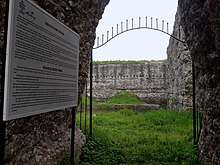Donuktaş
Donuktaş (literally “Pale Stone”) is a Roman temple in Tarsus ilçe (district) of Mersin Province, southern Turkey.
 Gate of Donuktaş | |
 Shown within Turkey | |
| Location | Tarsus, Mersin Province, Turkey |
|---|---|
| Coordinates | 36°54′59″N 34°54′12″E |
| Type | Temple |
| Length | 98 m (322 ft) |
| Width | 43 m (141 ft) |
| Height | 8 m (26 ft) |
| Site notes | |
| Archaeologists | Nezahat Baydur Winfried Held |
| Condition | In ruins |
Location
Donuktaş is in the urban fabric of Tarsus at 36°54′59″N 34°54′12″E It is to the east of other historical places of Tarsus anr to the north of Turkish state highway ![]()
Exploration history
The first written document about Donuktaş dates back to 1545. According to a member of the Venetian Barbaro family, who was the Bailo of Constantinople, Donuktaş was a palace. But according to later accounts in the 19th century, it is a mausoleum. The French historian Victor Langlois (1829–1869) in his book Voyage Dans la Cilicie et Dans la Montagnes du Taurus 1852-1853 described Donuktaş as the mausoleum of Sardanapalus (612-605 BC), the last Assyrian king. The German archaeologist Robert Koldewey (1855–1925) supported this assertion. British orientalist William Burckhardt Barker (1810?–1856) on the other hand, believed that Donuktaş is a mausoleum of another king. However, during the systematic exploration between 1982 and 1992 by Turkish archaeologist Nezahat Baydur, Donuktaş was defined as a temple built in the 2nd century, during the Roman Empire, much later than the Neo-Assyrian Empire (911–609 BC).[1] Originally, It was a temple of Sandon, an ancient Hittites deity. Later, Sandon was identified with the Roman god Jupiter, and the temple became a Temple of Jupiter.[2] The exploration continued after 2007 by the German archaeologist Winfried Held.[3]
The building
The building is huge construction without a roof. It has a rectangular form oriented in northeast to southwest direction. Its length is 98 m (322 ft) and the width is 43 m (141 ft). It is surrounded by 6.5 m (21 ft)-thick walls. The walls are about 8 m (26 ft) high. The building material is Roman cement.[2] Although the wall is presently naked, it was originally covered by marble.
References
- Taylan Köken:Archaeology essays (in Turkish)
- Marsin Valiliği: Mersin Ören Yerleri, İstanbul, 2009, ISBN 978 605 4196 07 4 p.87
- Paper by Ali Akın Akyol, Yusuf Kağan Kadıoğlu and Winfried Held pg. 83 (in Turkish)